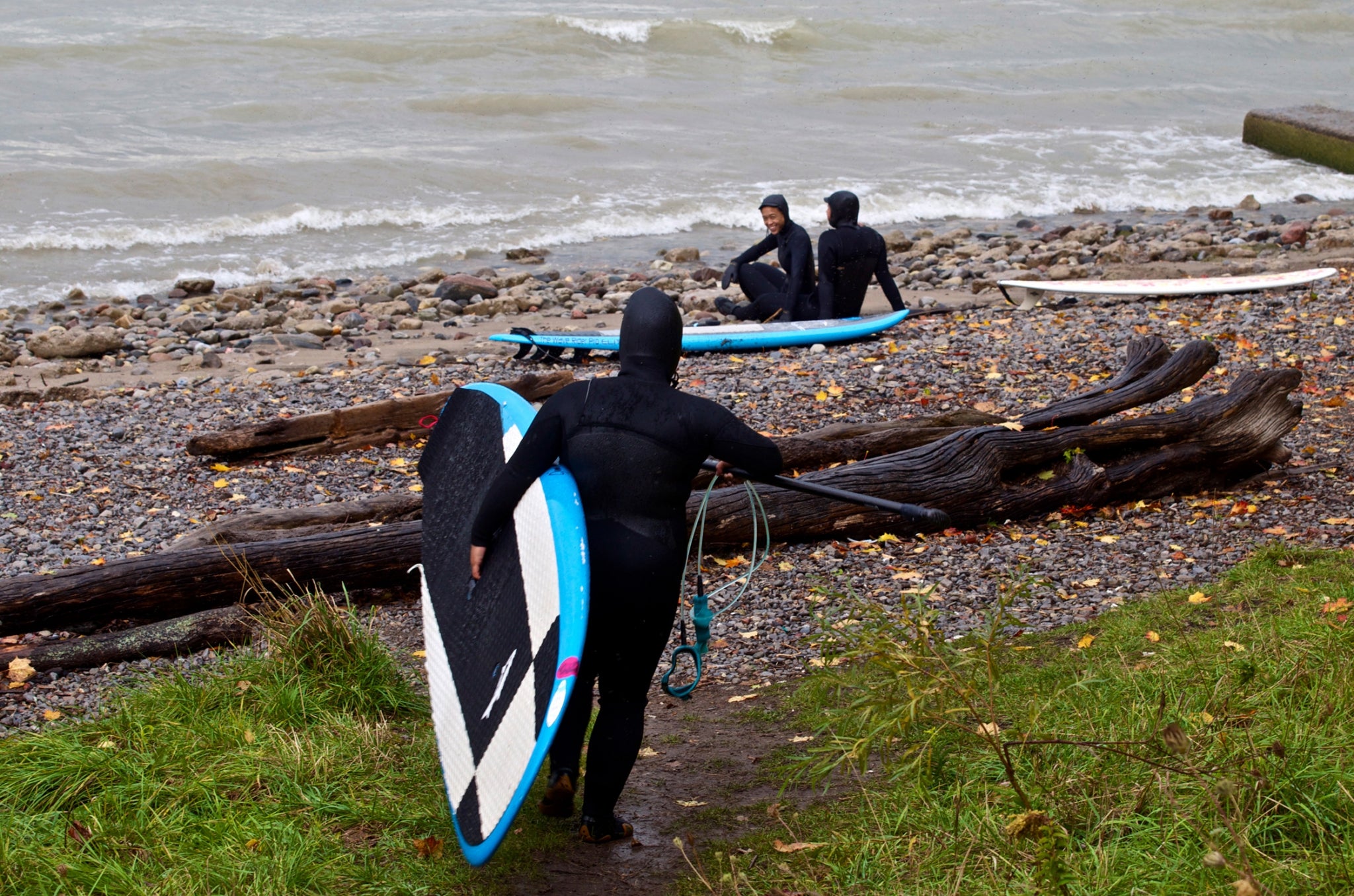Is Surf Culture on the Rise Again
This Bully Lakes surfer never felt represented in the surf scene, and then she created a new surf culture of her own.
The swell roared, crowds cheered and momentum grew as Robin Pacquing approached her offset wave on Lake Ontario. At least, it felt that way. Information technology was 2005, and Pacquing, a Canadian surfer who'd chased waves in Hawai'i and Tofino, BC, had yet to tackle the surf off the shores she grew up exploring.
"Information technology felt like the biggest wave in the world," Pacquing said, laughing. "But, information technology was perchance ankle-high surf." And that cheering section? It was a lone domestic dog walker, excitedly celebrating Pacquing'due south victory from Ontario'south Mississauga waterfront.
Symbolically, this moving ridge was everything for Pacquing. It sparked her lifelong journey with surfing, and that journey ultimately shaped today's Cracking Lakes surf culture. "For me, that moment was life changing," she said.
Pacquing, the girl of Filipino immigrants, had long adored the world of surfing. She binge-watched Baywatch and pored over surf magazines as a teen. But, like almost media consumed during her childhood, Pacquing never felt represented. "I'm short, stout, brown, non tall or blonde—that's just my genetics," she said. Simply Pacquing kept on surfing, and her heritage became her reason to paddle out. "I knew surfing had Indigenous roots with Hawaiians and islanders," she said. "While I'm not from the Philippines—I was born and raised in Canada—my roots are there. I felt like that was my merely in, and that's why [surfing] felt OK."
Pacquing learned to surf at Waikiki beach in 2000. She was 20 during that first lesson and spent subsequent years plotting to motility almost the body of water. But when she uncovered the secret globe of Cracking Lakes surfing in 2005, her life calling took shape. She adept religiously, made a name for herself and used that experience and esteem to cultivate the very thing she'd lacked growing upwards: a diverse and inclusive surf culture.

For Bully Lakes surfers, warm water and globe-class waves aren't necessary to get the fire stoked. Robin Pacquing slides down the face of a classic double-over-ankle-loftier peeler. Photograph: Greg MacLeod
It'southward tough to change a deep-rooted culture in established surf meccas like California and Hawai'i, and surf norms are notoriously slow to adapt. Up until the 1990s, women made upward a small fraction of the surf population. And into the 2010s, the media largely objectified and hyper-sexualised female surfers rather than celebrated their skill and athleticism in the water. Today, the landscape's dissimilar: Women make upwards between xx to xxx percentage of the surf world and defended female surfers have rallied for landmark changes, including the World Surf League announcing prize-money equality in 2019.
Meanwhile, dorsum in Pacquing's dwelling in Oshawa (near Toronto), and beyond the Bully Lakes region, surfing is all the same relatively new. That'south non to say surfers haven't been catching waves here for decades. They have, and documentaries like Unsalted: A Great Lakes Feel brand that clear. But Keen Lakes surfing has always been more discussion-of-mouth, similar a secret gild. Merely recently, through social media and articles in both surf magazines and media outlets such as The New York Times, has the unexpected sport become more mainstream.
"It's like the final frontier for surfing," Pacquing said of the Great Lakes surf scene. "The thought of actual surf doesn't be here. In that location'south zero expectation, and that breeds this civilization of stoked people making exercise with what they have."
Pacquing's early on adoption of Dandy Lakes surfing and the region's pure, raw enthusiasm for it were the perfect ingredients for a new and welcoming surf civilization. In 2014, she and Canadian artist and surfer Lisa Parkes dreamed up the idea of Lake Surfistas, a grassroots group that inspires women of all abilities to surf, SUP (stand-up paddleboard) and SUP surf beyond the Groovy Lakes. They launched the kind of customs Pacquing could've used as a teen, with a 30-person beach solar day result on Lake Erie that October. Today, the group has over 1,000 members of all ages, identities and ethnicities.
"A lot of the women entering the scene weren't immature similar we expected," Pacquing said. "They were women of ways. They had careers. They were moms, or they were not moms. A lot of us were just out of relationships and redefining ourselves. You don't take to be super pro or rad, sponsored, whatever. Y'all've just got to honey it."
Pacquing, who alternates between surfing, SUP surfing and SUP takes this beloved of sport seriously. She's a World Paddle Association-certified SUP instructor; the first Asian-Canadian member of Wyldewood Surf Gild, 1 of the Great Lakes' oldest surf institutions; and a certified surf gauge with the International Surfing Association. She's likewise going on a streak of over fourscore sequent months surfing at least once per month on the Great Lakes.
This is no dubiety an impressive resume but being renowned in the Neat Lakes surf community is only part of Pacquing'south story. The other half is a lesson in perseverance and a reminder that cocky-acceptance is a never-ending process, even for established surfers.
"I haven't always been positive near my body, e'er since I was a little girl," she said. External forces like the media and peers weren't the only factors at play. "I was called taba (fat) oft by my family," she said. "If you are familiar with Filipino culture, and then yous'll know beingness called names like this were damaging but also given with love and endearment."
Torso-paradigm struggles and naysaying filled Pacquing's life during a foundational time: adolescence. "I was hindered in sports considering I was asthmatic, and I had teachers who told me that I couldn't play sports because of who I was and what I looked like," she said. "In the sixth grade, I wanted to endeavor out for the lawn tennis squad. I had a teacher who outright said, 'No, not you lot.'"

Pacquing cantankerous-steps upwards her SUP on a solid day of surf for Lake Ontario. Photo: Geoff Ortiz
Pacquing listened to her teacher; she learned music instead. Just her dearest for the Cracking Lakes and outdoor adventure persisted, thank you largely to her father who embraced and introduced his children to Canada's outdoor pursuits similar skiing. "My dad just threw himself into it," she said. Pacquing's parents immigrated to Canada from the Philippines in the early 1970s. Connecting with nature was integral to her babyhood. "They instilled in my brothers and me that nosotros needed to be exterior and in order for united states of america to really feel similar nosotros belonged in this country, nosotros needed to be role of the state," she said.
When Pacquing had that transformative commencement Lake Ontario surf in her mid-20s, it helped change her mindset. "I had been considering moving out of the state to alive by the coast merely learning nigh Great Lakes surfing is one of the reasons I stayed," she says.
Past staying in Canada and spearheading a surf move, Pacquing proved the naysayers wrong. Merely one critic lingered: herself.
Pacquing's body credence wavered throughout her 20s and 30s. She was in her surfing prime, but similar and so many athletes and women, idealized portrayals of other women's weight and images made her self-conscious of her own. Now, having just turned xl, Pacquing is overcoming many of these esteem and cocky-worth bug. But that doesn't brand body acceptance any easier.
"Seeing how my body has changed from when I first rode a wave twenty years ago to at present, it'south heaps of departure," she said. "My muscle retentivity is better now, but the speed and ferocity, my tolerance to cold—I'thou feeling that. This is something I've been personally dealing with for a long fourth dimension. Instead of focusing on weight or image, though, at present it'southward similar, 'Can I feel good in the trunk I'm in? Can my torso move the way I desire it to movement?'"
Her friends and fellow surfers across Lake Surfistas, the very people she motivated to kickoff surfing, are now helping her navigate this journey. "Some of us [in Lake Surfistas] are in our 40s and 50s," she said. "Seeing the life experience of those who are older than me is like a window of what to wait."
And, as Pacquing learns to encompass her body in this new decade of life, she often forgets just how many young, underrepresented surfers she's encouraging past simply doing what she loves.
"We have so many younger women who have much more energy than I accept, only information technology'south inspiring because some of them accept come upward to me to say, 'You opened the door, so I don't feel so hindered. I feel welcomed because you did it,'" Pacquing said. "If I helped make this customs feel a petty more than comfortable, then astonishing. I've washed what I'thou supposed to do."
Imprint Paradigm: For Great Lakes surfers, warm h2o and world-class waves aren't necessary to get the burn stoked. Robin Pacquing slides down the face of a archetype double-over-ankle-loftier peeler. Photo: Greg MacLeod
____________________________________________________________________
Writer Contour

Stephanie Vermillion
Stephanie Vermillion is a journalist and photographer based in Cleveland,
Ohio. She covers outdoor adventure and travel, with work published in
National Geographic , Outside and Travel & Leisure.
harrislearallings.blogspot.com
Source: https://www.patagonia.com.au/blogs/roaring-journals/a-new-surf-culture
0 Response to "Is Surf Culture on the Rise Again"
Post a Comment